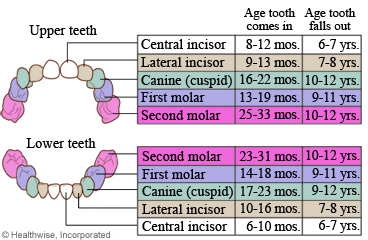
Overview
Teething is the normal process in which your baby's first set of teeth break through the gums (erupt). Teething may begin around 6 months of age, but each child is different. Teeth often come in first in the front of the mouth. Lower teeth usually erupt 1 to 2 months earlier than their matching upper teeth.
Your child may be irritable and uncomfortable when teething. Your child may bite on fingers or toys to help relieve the pressure in the gums. Children sometimes drool more during this time. The drool may cause a rash on your child's chin, face, or chest.
Teething may cause a mild increase in your child's temperature. But if their temperature is above 100.4 F (38 C), look for symptoms that may be related to an infection or illness.
Try rubbing the gums and giving your child safe objects to chew on to help ease the pain.
Follow-up care is a key part of your child's treatment and safety. Be sure to make and go to all appointments, and call your doctor if your child is having problems. It's also a good idea to know your child's test results and keep a list of the medicines your child takes.
How can you care for your child at home?
- Give acetaminophen (Tylenol) or ibuprofen (Advil, Motrin) for pain or fussiness. Do not use ibuprofen if your child is less than 6 months old unless the doctor gave you instructions to use it. Be safe with medicines. Read and follow all instructions on the label.
- Gently rub your child's gum where the tooth is erupting for about 2 minutes at a time. Make sure your finger is clean, or use a clean teething ring.
- Do not use teething gels for children younger than age 2. Ask your doctor before using mouth-numbing medicine for children older than age 2. The U.S. Food and Drug Administration (FDA) warns that some of these can be dangerous. Talk to your child's doctor about other teething remedies.
- Give your child safe objects to chew on, such as teething rings. Do not use fluid-filled teethers.
- If your child is eating solids, try offering cold foods and fluids, which help to ease gum pain. You can also dip a clean washcloth in water, freeze it (but let it soften a little), and let your child chew on it.
When should you call for help?
Watch closely for changes in your child's health, and be sure to contact your doctor if:
- Your child has a fever higher than 100.4°F (38°C).
- Your child is vomiting, has diarrhea, or has a severe diaper rash.
- Your child is fussy and keeps pulling on their ears.
- Your child is 18 months old and has not had an erupting tooth yet.
Where can you learn more?
Go to http://www.healthwise.net/patientEd
Enter C015 in the search box to learn more about "Teething in Children: Care Instructions".
Current as of: October 24, 2023
Author: Healthwise Staff
Clinical Review Board
All Healthwise education is reviewed by a team that includes physicians, nurses, advanced practitioners, registered dieticians, and other healthcare professionals.

